Most Nurses Today Have Considered Quitting—Here Are the Most Effective Ways To Keep Them
The partnership between providers and nurses is vital to the success and ongoing operation of any healthcare organization. Neither job is easy, and recent staffing shortages have pushed nurses to the brink.
As the recent strike of New York nurses [1] comes to a tentative close, it’s crucial for healthcare employers to recognize that the underlying causes for nurse burnout haven't been fixed—and it’s up to them to make workplace improvements to retain these qualified workers.
To help, we surveyed nurses in the U.S. to uncover their biggest challenges, why so many are leaving the profession, and three ways employers can fix it.*
Key findings
The desire to help people was the number one reason (87%) nurses chose to pursue their career in medicine, and 99% of nurses feel they have a positive impact on patients.
However, 60% of nurses say the quality of care they are able to provide has diminished over the past three years, and 68% have recently considered leaving their current job.
The top three nursing pain points are caring for too many patients in a day (61%), hours spent on administrative tasks (60%), and increased workload due to co-workers leaving (59%).
Nurses love the job, but hate the burnout
Our survey clearly shows that nurses feel a noble calling. Eighty-seven percent of surveyed nurses say the desire to help people was the reason they became a nurse in the first place.
An astounding 99% of nurses believe they make a positive impact in their patients’ lives, and 67% of nurses say they are likely to recommend a career in nursing to someone in school right now, which indicates a level of contentment with their chosen profession.
All of this is great news, and it’s encouraging to know that nurses feel fulfilled in their work. However, nobility isn't enough to keep nurses happy with their jobs—nor will it prevent them from feeling burnt out or overworked. Especially as we consider the current cycle of COVID-19 surges, high employee turnover, and inflation.
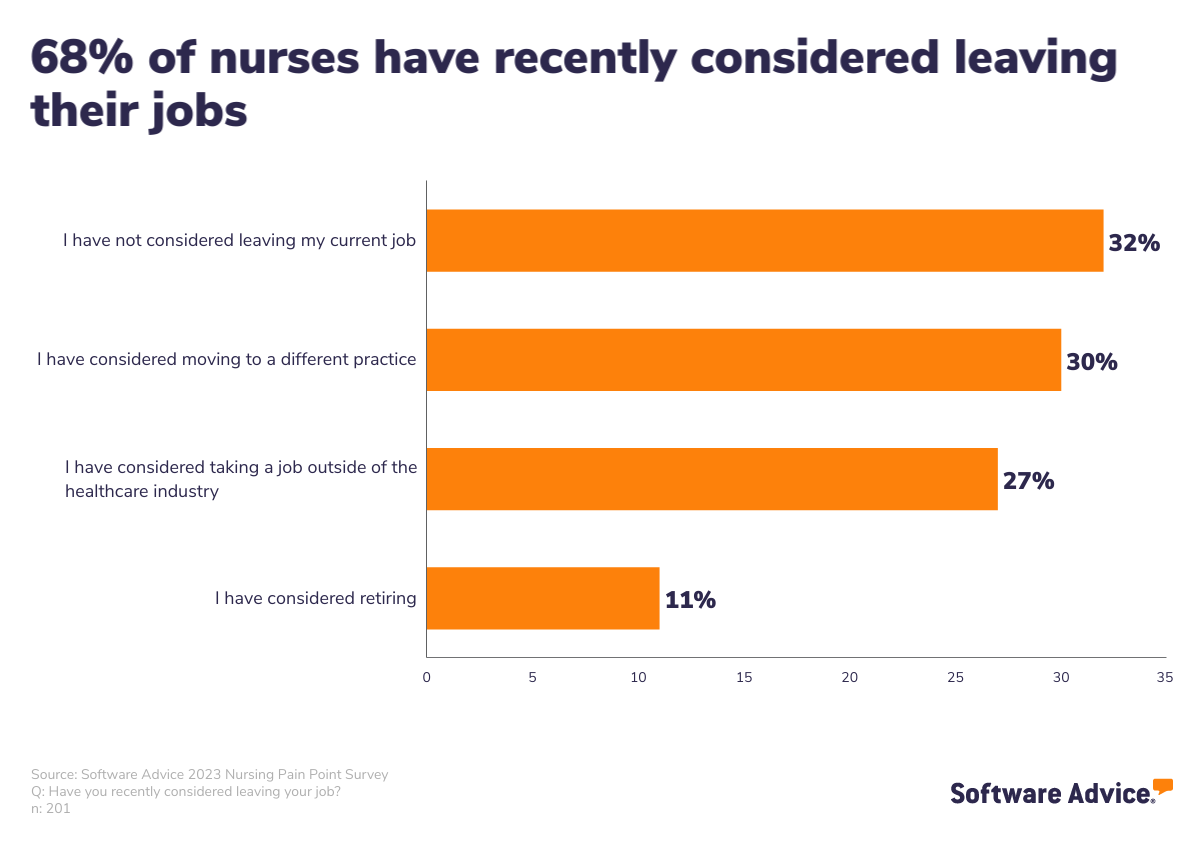
More than half of nurses say the quality of care they are able to provide has diminished in the past three years, and 68% have considered leaving their current job.
We asked nurses in our survey about the specific challenges that are pushing them to consider quitting, and the top three pain points they identify all boil down to an imbalance between the amount of work to do and the number of nurses available to do it.
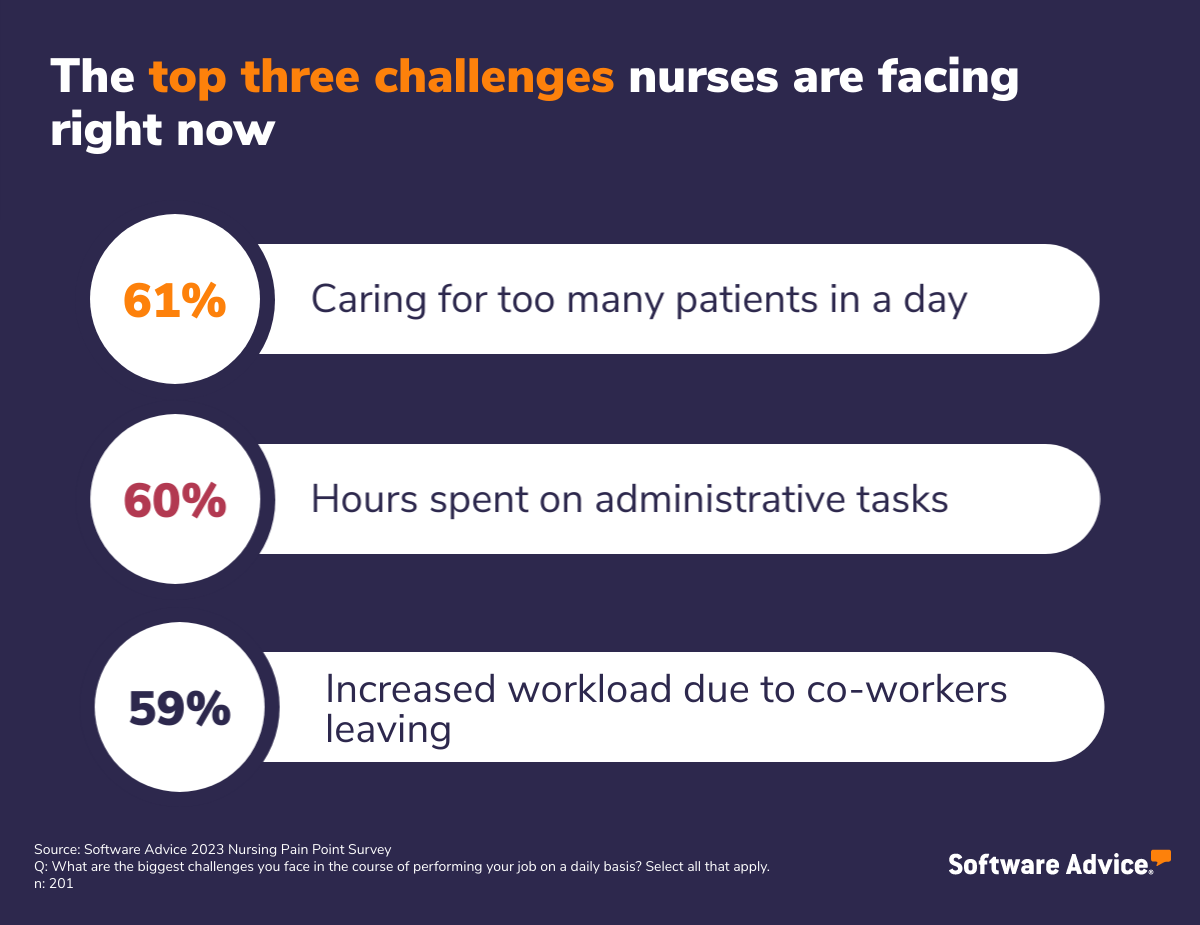
That’s not a simple fix. You’ve got to deal with finding, hiring, paying, and retaining qualified talent in the midst of a worker shortage. All while already dealing with inflation and patient surges due to COVID-19 and other seasonal illnesses.
It’s a tough situation all around, but the buck has to stop somewhere. Most solutions to these problems are financial, but you absolutely should prioritize them if you want to get on top of the issue. Doing so will allow you to attract and retain exceptional talent, which will in turn elevate your patient experience (an increasingly important consideration as we face the rise of patient consumerism in healthcare).
With all this context in mind, let’s explore three ways you can improve your nurses’ job experience and help them through this difficult time.
Fix #1: Pay them more
You probably knew this was going to be our top recommendation, but that doesn’t make it any less valuable. For most nurses, a pay raise would go a long way toward making their jobs (and lives) easier.
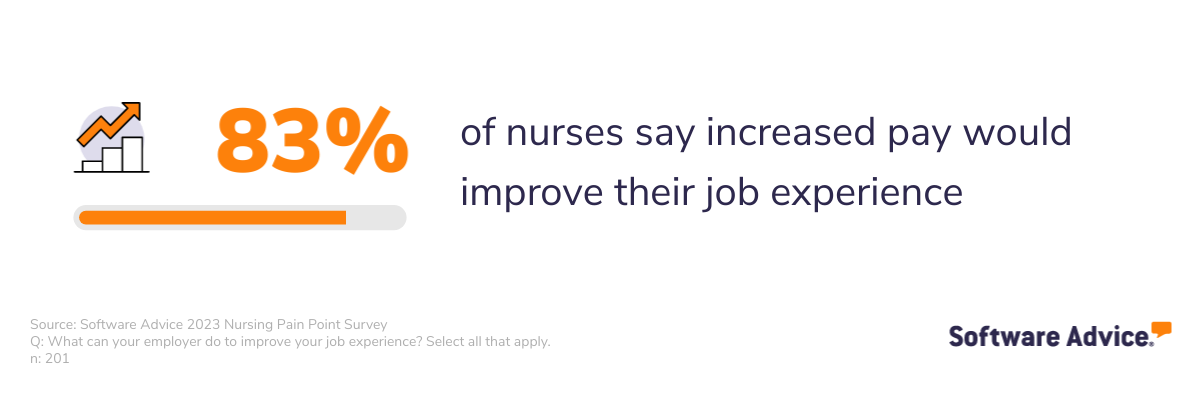
While employees can’t necessarily expect salary increases to match inflation rates exactly, 83% of nurses say they don't feel their salaries have kept up with inflation at all. At the time of reporting, the annual inflation rate in the U.S. is hovering around 6.5%.
For reference, we found that most nurses make at least $75,000 (but the majority in our survey make more than that). If we use this salary as an example, and consider a raise in line with the current inflation rate, that means these nurses would expect a raise of about $4,875.
If that’s not an option for you, though, consider finding other ways to support your nurses financially. One example is contributing to the cost of their required continuing education.
Over a third of surveyed nurses say they are entirely responsible for the cost of their ongoing educational credits. This is something employers could consider contributing to, as it has several benefits for your practice.
For example, by supporting your nurses’ skill development, you empower them to bring those new skills back to your practice, making it easier for you to expand on your practice’s offerings, keep up to date with the latest medical care and technology, and stay on top of the most relevant diagnostic tools.
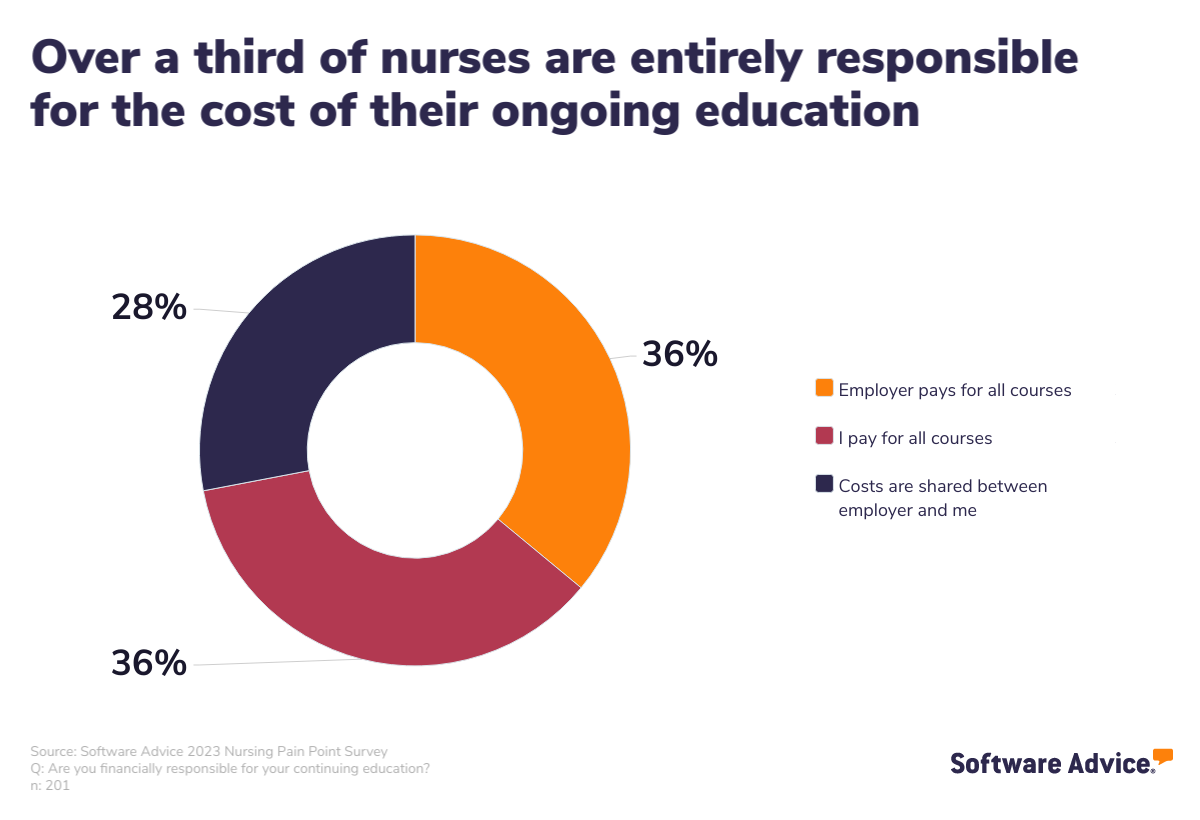
Fix #2: Hire more support
All three of nurses' top complaints right now are related to their workload. The best way to fix these problems is to hire more nurses to spread the work more equitably.
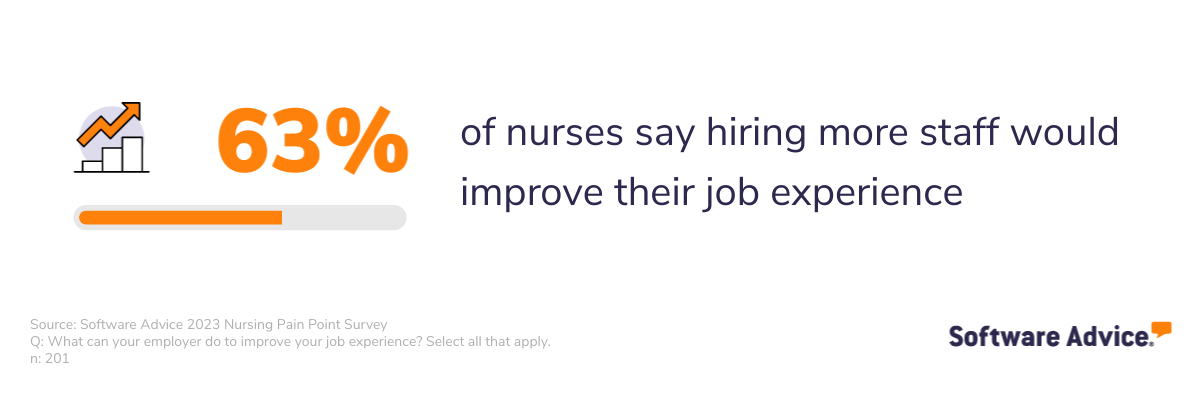
Something else to consider in this area is the broader impact of staff shortages on your entire organization. For example, 53% of nurses say patient feedback is factored into their performance reviews, but the value of that metric must be considered in the context of reduced staff.
If your nursing team is stretched thin, that very well may be represented in patient feedback. And if you use that feedback to justify a mediocre or poor performance rating, you’re likely to drive away your talent.
Instead, focus on bringing new talent in to support your existing staff by improving your employee value proposition.
Need hiring/recruitment help?
We've got you covered with this guide: "Of All The Recruitment Strategies in Healthcare, This is The One to Get Right"
Fix #3: Lean into software solutions
Our last recommendation has less to do with HR and everything to do with IT. One of the biggest complaints nurses have right now is how much time they need to spend on administrative tasks—entirely understandable when you consider the additional work they’re doing to see more and more patients with fewer and fewer nurses.
For 60% of nurses, increasing paid time off would make a big difference.
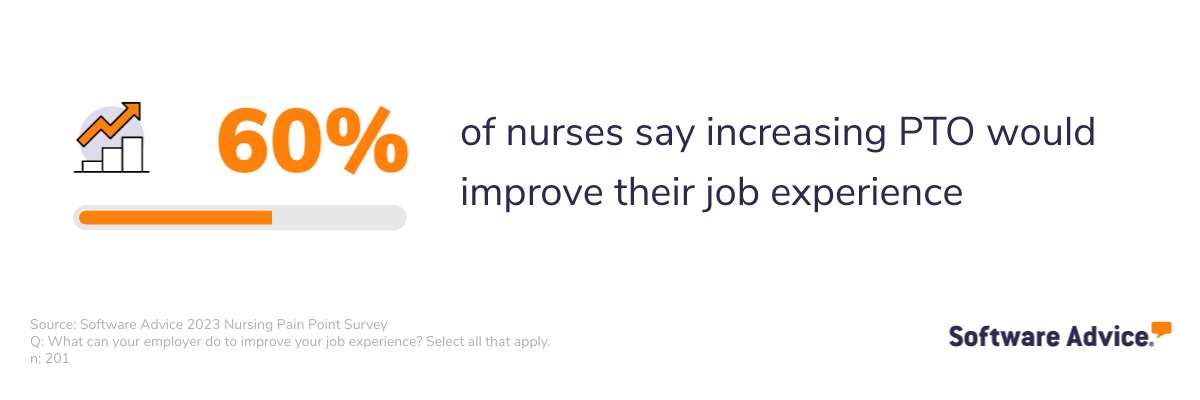
Except with the shortage of nurses, it’s hard to let your team have extra time off when you need them to show up to keep your practice functioning. A compromise: Using telemedicine to allow your nurses to work a few shifts a week from the comfort of their home.
For about a third of nurses (34%), that’s already the case.
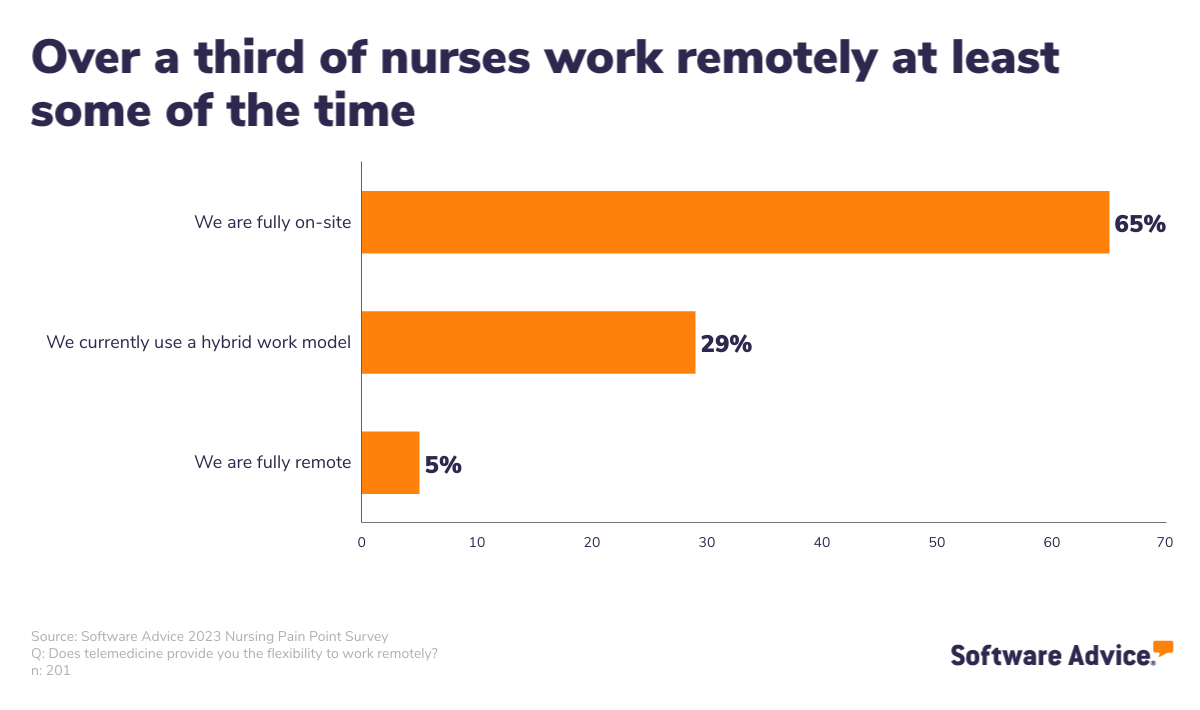
We know from other research that 91% of patients are more likely to choose a provider who offers telemedicine over one who doesn’t, so it’s clear that patients desire this technology.
The benefits of telemedicine go both ways: Patients enjoy faster, easier access to medical care, and providers enjoy more flexibility in their scheduling.
The most important recommendation is to exercise empathy and take action
While these survey findings prompt logical recommendations and specific ways you can ease the burden on nurses, the biggest takeaway to help your nurses this year is to practice empathy and take action.
Taking action can include automating administrative tasks using tools such as:
If none of the above recommendations work for your specific practice, go straight to the source to find out what your nursing staff needs from you.
Conduct your own employee survey to find out what your team’s biggest complaints are, and then take the time to consider solutions that are specific to your workplace.
A customized solution that takes your specific employees (and their feedback) into account will work better than a generic approach, and will also go a long way to show your nurses that you’re listening to them and you care about the issue they’re facing.
Survey methodology
Software Advice's 2023 Nursing Pain Point Survey was conducted in December 2022 among 201 registered nurses, nurse practitioners, and physicians' assistants in the U.S. who have been working in their current job for at least one year. The purpose of the survey was to identify the key challenges nurses are facing in their jobs at this time and what specific solutions their employers can provide to support them in their role.